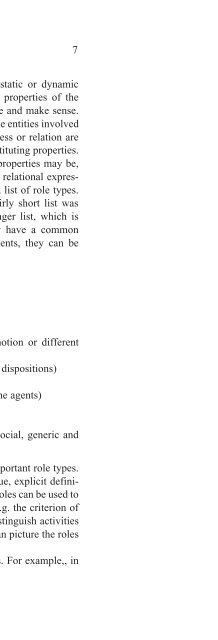Cognitive Semantics : Meaning and Cognition
Cognitive Semantics : Meaning and Cognition
Cognitive Semantics : Meaning and Cognition
Create successful ePaper yourself
Turn your PDF publications into a flip-book with our unique Google optimized e-Paper software.
24 PETER GÄRDENFORS<br />
V. <strong>Semantics</strong> is primary to syntax <strong>and</strong> partly determines it (syntax cannot be<br />
described independently of semantics).<br />
This thesis is anathema to the Chomskyan tradition within linguistics. Within<br />
Chomsky’s school, grammar is a formal calculus, which can be described via<br />
a system of rules, where the rules are formulated independently of the meaning<br />
of the linguistic expressions. <strong>Semantics</strong> is something that is added, as a<br />
secondary independent feature, to the grammatical rule system. Similar claims<br />
are made for the pragmatic aspects of language.<br />
Within cognitive linguistics, semantics is the primary component (which,<br />
in the form of perceptual representations, existed before language was fully<br />
developed). The structure of the semantic schemas puts constraints on the<br />
possible grammars that can be used to represent those schemas. To give a<br />
trivial example of how semantics constrains syntax, consider the role of<br />
tenses. In a Western culture where time is conceived of as a line, it is<br />
meaningful to talk about three basic kinds of time: past, present <strong>and</strong> future.<br />
This is reflected in the grammar of tenses in most languages. However, in<br />
cultures where time has a circular structure, or where time cannot be given any<br />
spatial structure at all, it is not meaningful to make a distinction between, say,<br />
past <strong>and</strong> future. And there are languages which have radically different tense<br />
structures, which reflect a different underlying conceptual structuring of time.<br />
The Chomskyan tradition within linguistics has been dominated by syntactic<br />
studies. Since grammars are represented by formal rules, they are<br />
suitable for computer implementations. This kind of work has indeed been the<br />
main focus of computational linguistics.<br />
Within cognitive semantics, computer-friendly representations are much<br />
more rare. One notable exception is Holmqvist (1993, 1994, this volume),<br />
who develops implementable representations of image schemas <strong>and</strong> other<br />
concepts from the cognitive linguists. To some extent, he is inspired by<br />
Langacker’s compositional image schemas <strong>and</strong> Lang’s spatial models (see<br />
Lang, Carstensen <strong>and</strong> Simmons 1991), but he extends their formalisms to a<br />
much richer computational structure. In his model (1994), he also utilizes an<br />
old idea of Behaghel to generate grammatical structure solely from the valence<br />
expectations of different lexical items. The result is something that looks<br />
like a rule-governed syntax, albeit there is no single explicit syntactic rule in<br />
the system.















